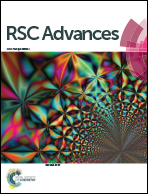Binder-free hierarchically-porous carbon nanofibers decorated with cobalt nanoparticles as efficient cathodes for lithium–oxygen batteries†
Abstract
The development of efficient cathodes is a great challenge inhibiting the advancement of lithium–oxygen (Li–O2) batteries. In the present study, binder-free, high surface area hierarchically-porous carbon nanofibers decorated with cobalt nanoparticles (Co–PCNF) are investigated as cathodes for Li–O2 batteries. We fabricate the nanofibers using a facile electrospinning technique followed by thermal treatment with in situ incorporation of cobalt nanoparticles. This method provides a free-standing, electron-conducting network with a hierarchical pore structure and effective dispersion of cobalt nanoparticles, which is directly used as a cathode in Li–O2 cells without any binders. Li–O2 cells with Co–PCNF as the cathode exhibit a high initial discharge capacity of 8800 mA h g−1 at the current density of 100 mA g−1, and can be recharged for more than 50 cycles with a limited discharge capacity of 500 mA h g−1. In comparison, porous carbon nanofibers without cobalt provide a discharge capacity of 6670 mA h g−1, and a cycle life of only 35 cycles. The post mortem analysis of discharged cathodes revealed Li2O2 as the major discharge product, and suggested a LiO2-mediated reaction mechanism responsible for the excellent performance of Co–PCNF.


 Please wait while we load your content...
Please wait while we load your content...